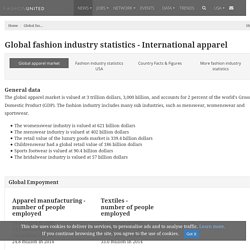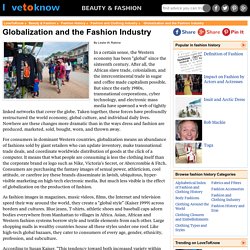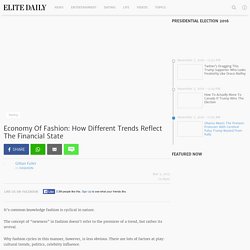

Global fashion industry statistics - International apparel. Total trade of clothing and textiles: 726 billion dollars The most traded apparel and textile products are non-knit women’s suits, knit sweaters, knit T-shirts and non-knit men’s suits.

Non-knit women’s suits: 54.6 billion dollars, 7.5 percent Knit sweaters: 52.8 billion dollars, 7.3 percent Non-knit men’s suits: 43.4 billion dollars, 6 percent Knit T-shirts: 36.9 billion dollars, 5.1 percent Knit Women’s suits: Knit women’s suits: 28.2 billion dollars, 3.9 percent Light rubberized knitted fabric: 23.9 billion dollars, 3.3 percent Synthetic filament yarn woven fabric: 20.9 billion dollars, 2.9 percent Raw cotton: 18.9 billion dollars, 2.6 percent Non-retail synthetic yarn: 18.8 billion dollars, 2.6 percent.
No 'Brexit effect' in latest jobs data. Image copyright AFP Economists have said the slight fall in UK unemployment to 1.63 million between May and July shows there is yet to be a "Brexit effect" on the jobs market.

The unemployment rate was 4.9%, down from 5.5% a year ago and little changed from last month's rate, Office for National Statistics (ONS) data shows. Nearly three quarters of people who can work have jobs, a record high rate. Employment was "resilient" before and after the EU vote, despite predictions of an economic shock, analysts said. Kallum Pickering, an economist at Berenberg, said: "Although it is still early days, the UK labour market is yet to show any Brexit effect for the period immediately before and after the June 23 vote. "
Uk.businessinsider. File photo shows people walking past the window of a H&M store in Paris Thomson Reuters NEW DELHI (Thomson Reuters Foundation) - Swedish fashion retailer Hennes & Mauritz (H&M) said it was collaborating with trade unions, government as well as the U.N. to improve workers' conditions after a study found violations in supplying garment factories in India and Cambodia.

The study by the Asia Floor Wage Alliance (AFWA) found workers stitching clothes for H&M in factories in Delhi and Phnom Penh faced problems such as low wages, fixed-term contracts, forced overtime and loss of job if pregnant. The AFWA, a coalition of trade unions and labor rights groups, accused the Western high street retailer of failing on its commitments to clean up its supply chain. An official from H&M told the Thomson Reuters Foundation on Saturday that the fashion firm has been working actively to improve the lives of textile workers for many years.
"The issues addressed in the report are industry wide problems. Globalization and the Fashion Industry. In a certain sense, the Western economy has been "global" since the sixteenth century.

After all, the African slave trade, colonialism, and the intercontinental trade in sugar and coffee made capitalism possible. But since the early 1980s, transnational corporations, cyber technology, and electronic mass media have spawned a web of tightly linked networks that cover the globe. Economy Of Fashion: How Different Trends Reflect The Financial State. It's common knowledge fashion is cyclical in nature.

The concept of “newness” in fashion doesn't refer to the premiere of a trend, but rather its revival. Why fashion cycles in this manner, however, is less obvious. There are lots of factors at play: cultural trends, politics, celebrity influence. One one of the most surprising factors to influence the cycle of fashion, though, is the state of the global economy. If you think about it, it makes sense. During tougher times, if you need new clothes, the focus is less on passing fads and more on classic, quality pieces worth the expenditure because they’ll last (which also aids in cutting down cost per wear). As FIT professor John Mincarelli tells ABC News, “In rough economic times, people shop for replacement clothes,” adding “basics” prevail during an economic downturn.
Economist George Taylor was the first to notice the correlation between fashion and the economy; he developed the “Hemline Theory” to describe his findings. Pinterest How? The Potential of Pilgrim Retail. LONDON, United Kingdom — Each year, millions of pilgrims descend on Mecca in Saudi Arabia, Islam’s most holy city, for the Hajj pilgrimage.

This year’s Hajj took place from 10 to 15 September, during which time authorities expected an influx of up to two million people. In recent years, Saudi Arabia’s government has placed limits on the numbers of Hajj pilgrims, while major renovation and expansion projects are carried out to accommodate increasing numbers of religious visitors. On top of the pilgrim flows during Hajj, about 12 million pilgrims from abroad are expected to visit Mecca this year for Umrah (the pilgrimage to Mecca which can be undertaken at any time of year), a number the government plans to increase to 15 million by 2020.
This year, tourists in Saudi Arabia are expected to spend 33.6 billion Saudi Arabian Riyals (SAR) (about $9 billion).